Bigfoot dwells in Australia, but we call it macropod. The term macropod is derived from the Greek words makros (meaning large) and poús or pod (meaning foot).
Macropods cover a group of marsupials that have large hind feet and which move by bounding. They cannot move their legs independently and often propel themselves forward with the help of their tails. They also raise their babies in pouches. There are several species of macropod including kangaroos, wallabies, tree-kangaroos, pademelons, bettongs and potoroos, among others. Today I thought I would share some photos of two species of macropod, the Swamp Wallaby and the Long-Nosed Potoroo, found at Tidbinbilla Nature Reserve, just outside of Canberra (Australia).
The swamp wallaby is a medium sized macropod. Mature males weigh in at about 20kg and females 15kg. It is relatively abundant and adaptable. It lives in a wide range of forested habitats, with its range stretching from far north Queensland through to the southern most points of Victoria. It prefers to hang out in areas where there is a dense understorey of plants. It is sometimes called the Black Panther because it may be mistaken for a panther as it bounds along. When moving at speed, it sticks out its long black tail horizontally, while keeping its head low to the ground. I think you would have to be pretty lucky to spot that tail because they blend in so well with their environment.
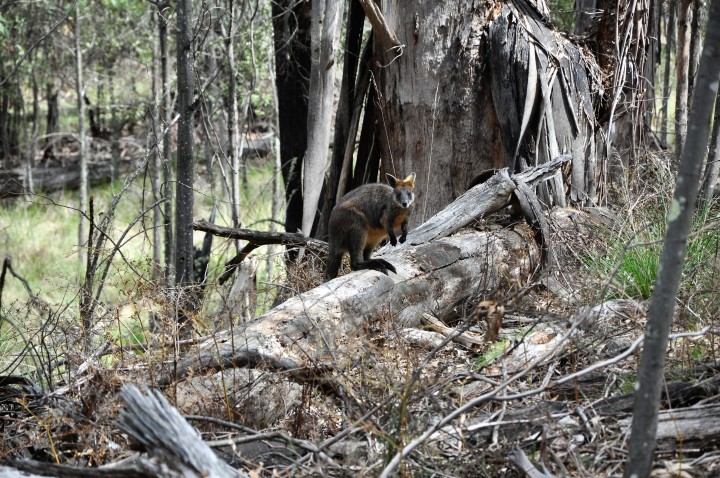

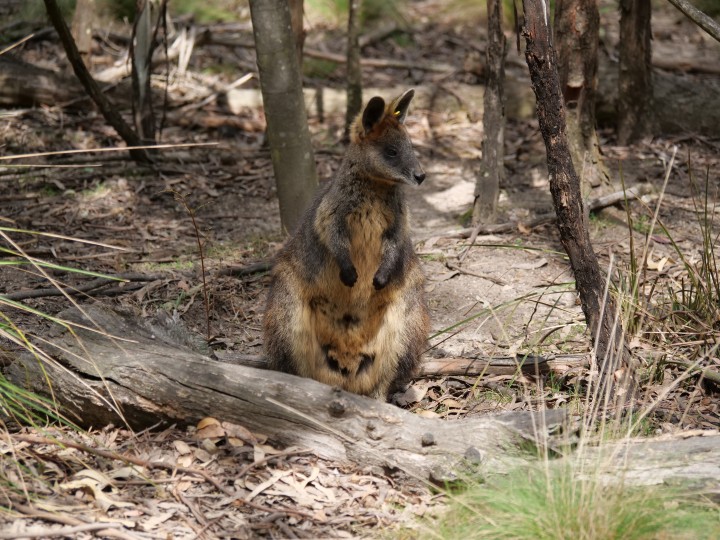
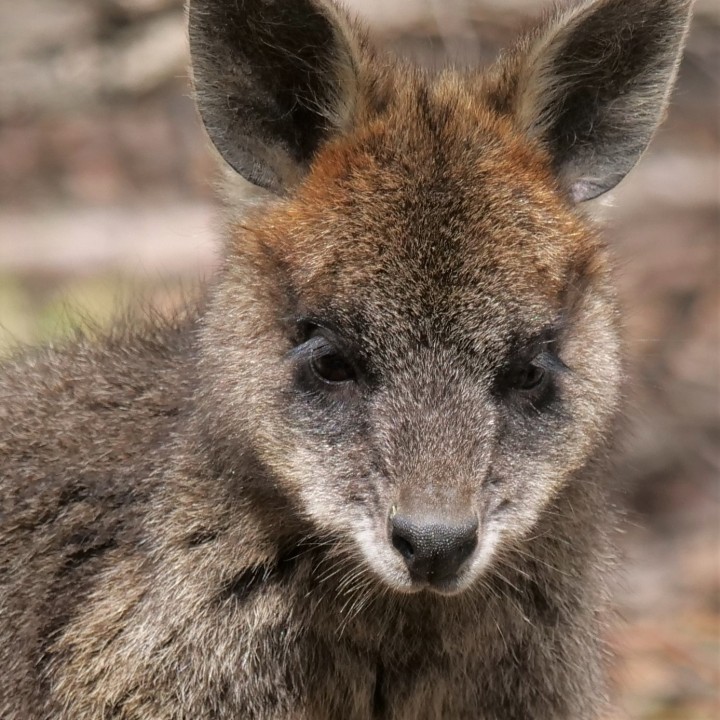
The second macropod in this post is the long-nosed potoroo. It is one of our smallest macropods and just adorable. But they have a problem. Their nickname is kangaroo-rat. Talk about how to win friends and influence people! I think their nickname needs a makeover because the current one doesn’t endear them to people. It is no wonder they are listed as vulnerable. After you’ve seen their photos, perhaps you can help come up with another nickname.
Potoroos are not indigenous to the Canberra region, but are being bred in captivity (in large multi-hectare enclosures) at Tidbinbilla. Here, they are safe from predation from foxes and feral cats. Potoroos need and deserve protection. Habitat protection is critical. Potoroos live in wet forests and scrubland which have a dense understorey. The understorey is vital for providing protection from predators. Potoroos have a symbiotic connection to eucalpyt forests because they rely on fungi associated with these trees and vice-versa. They don’t do well in areas where there are frequent wildfires. You would think that living in wet forest would reduce the risk of fires. However, wetland forests are drying out due to climate change.
The potoroo could so easily become critically endangered. I have a very personal example of how taking their presence for granted could hasten their departure from the landscape. Those of you who have been following my blog for a while will know that my mother lives on a rural property in central Queensland. When she first moved there, there were heaps of potoroos, but over the years they’ve almost completely disappeared. I think that is because many more people have moved into the area and have set up hobby farms. New residents clear the land, and bring their dogs and cats with them. They often know little of the potential impact of their activities on the wildlife that drew them there in the first place. Kangaroo rats are not rodents. Nor are they feral pests. They are wonderful and unique Aussie animals. Here’s an idea. Let’s educate current and prospective landholders about the animals on their properties and what they can do to ensure local wildlife thrive (mum, please share this with the local council). Anyway, dear Readers, you’ve waited long enough. Time for some photos.
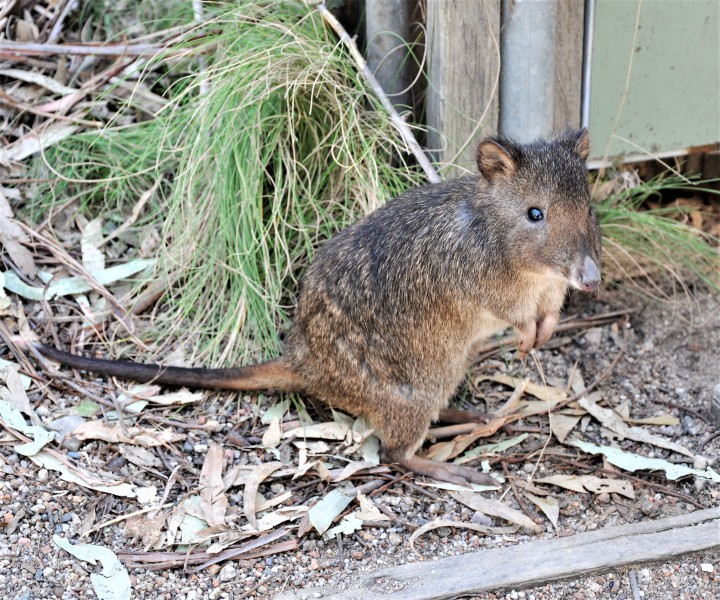

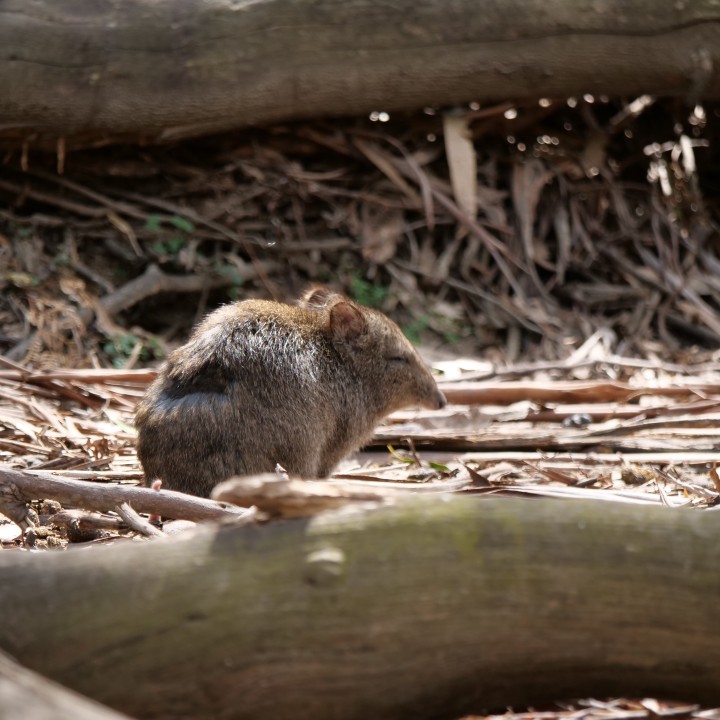

We would do anything for our dogs, right? Love me, love my dog. I think I’ll get a T-Shirt made that says, “Love me, love my potoroo.” Who could argue with that?
So have you thought of any alternate nicknames? The tooter-roo? The cutie-tooter? The podlet? The impossibly cute teeny bigfoot?
Kind Regards
Tracy
Response the Ragtag Daily Prompt — Pod. Click on the link to join in.
For further information on the swamp wallaby, see here, and on the long-nosed potoroo, see here and here.
Always learning something new from you. At first glance of the potoroo…I see a rat! But it is a cutie and I can see how its size would make it vulnerable!
LikeLike
Thanks Heather. A potoroo came to say hello. Clearly an opportunist. I was already a fan, but now I’m a groupie.
LikeLiked by 2 people
So interesting! I had no idea there were so many varieties.
LikeLike
I’m hoping to get a field guide for Christmas, Linda, so I can learn more about the different varieties.
LikeLiked by 1 person
Oh my gosh–so cute! And the eyelashes on the wallaby–!
LikeLike
I know. Wish I had eyelashes as lush as that. 🙂
LikeLiked by 1 person
You and me, both!
LikeLiked by 1 person
We have both wallabies and potaroos wild in the Huon Valley. I think they are cute but a friend who I used to house sit for was less enthusiastic and warned me to make sure that all her plant enclosures were secure after I watered them so the potaroos could not get in. She certainly had a lot visit her property and they were happy to stay in plain sight although they hopped away if I approached them.
LikeLiked by 2 people
Maybe your friend visited the potoroos’ place, Vanda. 🙂 Sharing is caring. Still if they can co-exist with just a few fences to protect the veggies, that seems fair.
LikeLiked by 1 person
That’s what she did, she had everything in little shade house type structures or open beds with nets but I think possums were the main culprits anyway.
LikeLiked by 1 person
Those possums do make themselves at home.
LikeLike
But I do sympathise with your friend, Vanda. I’ve put a lot of sticks and other garden debris under my plants to stop the dogs digging them up. This has attracted a lot of skinks to the garden. So then I’ve had to fence the plants off, but the skinks don’t confine themselves to those areas. The dogs have killed three recently. I despair.
LikeLike
It’s very hard sometimes if you love pets but also enjoy wildlife in your garden. My current cat Polly is an inside cat. If she goes into the garden it is only with me under supervision. I always tried to keep her predecessors indoors at night but she is the first fully indoor one. That way I can still enjoy the birds and as a bonus don’t have to worry about her getting into fights or getting run over.
LikeLike
Perhaps I need an outdoor cat run for the dogs. Kudos to you, Vanda, for being such a responsible cat owner.
LikeLike
I think it will be the law everywhere one day but in the meantime it’s better for the environment and better for the cat. She doesn’t miss roaming as she’s never done it and she’s lazy anyway, won’t even climb a tree. 🙂
LikeLiked by 1 person
I hope so, Vanda.
LikeLike
Such a beautiful creature, and a wonderful post – no one could argue with that!
LikeLiked by 1 person
Thank you, Paul. You’re very kind. Is there a WA equivalent of the potoroo?
LikeLike
In WA we love our Quendas (Southern Brown Bandicoot), they have their own facebook page :), but I think our Woylies are closest to Potoroos for endangered status.
LikeLiked by 1 person
There is a lot to love in those Quendas and Woylies, Jenn. Very sweet creatures. Thank goodness for the good work of dedicated ecologists and volunteers trying to save them.
LikeLike
Other than the roos and wallabies, the only other common macropod is the larger Quokka of which there are two types in WA (and not just on Rottnest Island either), except in 1994 A small colony of Gilbert’s Potoroo was found near Esperance (originally thought to be extinct) so we do have Potoroos too.
LikeLiked by 1 person
How exciting it must have been when the Gilberts were discovered. One of my other WA readers mentioned the Quendas and Woylies in WA. What fabulous names!
LikeLiked by 1 person
Yes, Quendas are the southern brown Bandicoot, and Woylies are Bettongs, both rather cute.
LikeLiked by 1 person
Well, that was fascinating. Does anyone know why marsupials are only found in Australasia?
LikeLiked by 1 person
Marsupials are found in North and South America. The most common is the Virginia opossum. The Virginia opossum is found as far north as parts of Canada. The latest theory is that the opossum is an ancient ancestor of Australian marsupials.
LikeLiked by 2 people
Oh, thanks for that. I had no idea.
LikeLiked by 1 person
It is indeed, Sid. I’ve put a link to the UK’s Natural History Collection for Margaret.
LikeLike
The macropods, a sub-class of marsupials, are native to Australia and PNG, but marsupials are more widespread. Check out this link from your wonderful Natural History Collection, Margaret. It is very easy to read and very informative. http://www.nhc.ed.ac.uk/index.php?page=493.168
LikeLike
Google the Virginia Opossum, they have faces that only a mother could love.
LikeLike
I love Australia. These guys are beautiful.
LikeLiked by 1 person
I thought you would love these, Martha. 🙂
LikeLiked by 1 person
Another great batch of photos–thank you for sharing!
LikeLiked by 1 person
I’d never seen a potoroo before, what an adorable creature Tracy – your photographs are beautiful! 🤗💖 xxx
LikeLiked by 1 person
Thank you, Xenia. That means a lot.
LikeLiked by 1 person
🙂💖🙋♀️ xxx
LikeLiked by 1 person
Beautiful pictures your marsupials are very photogenic!
LikeLiked by 1 person
They are gorgeous. 🙂
LikeLike
We do have such unique and beautiful animals over here and your photos show how cute and attractive they are
LikeLiked by 1 person
Thank you, Pauline. I hope I show their personalities.
LikeLiked by 1 person
Thanks for letting people know about our native animals Tracy
LikeLiked by 1 person
And thank you for looking after the animals’ habitat on your property, Brian.
LikeLiked by 1 person
This was such a great read! I loved learning about your Macropods 🙂
LikeLiked by 1 person
Thank you, Christine. Glad you enjoyed it.
LikeLike
I just saw this post. Absolutely adorable! The colours, quite amazing. Looks like you’re having a lot of fun with your camera!
LikeLiked by 1 person
I am. No good for landscapes though. Not that I’m complaining. 🙂
LikeLiked by 1 person
Yes I’m not good with landscapes either. Still trying to work out the panoramic shot on my iPhone! lol
LikeLiked by 1 person